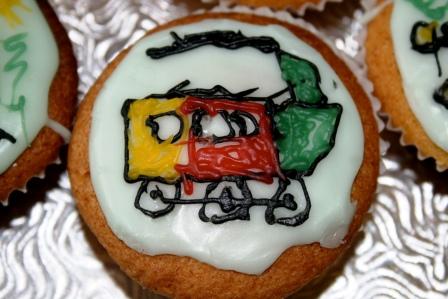Padiham Greenway

History
The Padiham Greenway has been created on a disused railway line that runs between Rosegrove and Padiham in Burnley. This was one of the most expensive lines built by the Lancashire and Yorkshire Railway. Although construction was problematic, the first passenger train left Padiham Station on 1st September 1876, the line was discontinued in 1964. To download a document about the history of the site, click here.
The site has been redeveloped by Lancashire County Council's REMADE team with support from Sustrans Connect 2 Project, The Northwest Development Agency, Lancashire County Council Arts Development Service, Burnley Borough Council, British Waterways and Mid Pennine Arts. The Padiham Greenway is being developed as part of a longer route between Great Harwood and Burnley which is designed to create an off-road trail that connects people to facilities and open spaces in and around the towns that flank the route.
Creative Engagement Programme
For a summary of this project, click here.
Mid Pennine Arts engaged the local community with this new outdoor space through a creative investigation of the history of the railway and the community’s connection to the site. A series of interconnected projects were led by artists specialising in community work, media, dance and sculpture. The Padiham Greenway Creative Engagement programme ran from March 2010 to January 2011 and consisted of 12 creative projects, integrating an extended schools cluster programme. There was also a celebration week in June 2011, culminating in the Padiham Greenway Pageant.
The project engaged 7121 people, and 22 artists were involved in project delivery.
Ecology Project
February - November 2010 | Sue Flowers
The Ecology Project led by artist Sue Flowers saw children taking part in drawing and painting workshops, making designs for tree and bulb planting along the Greenway. The project increased awareness and greater knowledge of the ecology of the Greenway and was a prime contributor to increasing the sense of ownership of the area by the young people.
Historical Tea Parties
May 2010 - January 2011 | Sue Flowers
Historical tea parties brought together numerous creative workshops and provided great opportunities for members of the local community to be interviewed resulting in a collection of oral and written histories. Historical Tea Parties Booklet was produced during April - July 2011 showcasing the art work and documenting the communities oral history previously gathered at the ‘Historical Tea Parties’.
Media Project
June - July 2010 | Jenson Grant
Artist,Jenson Grant led a filming project that involved a secondary school working with 2 primary schools between April and July 2010. This taught young people new skills and gave them the opportunity to express their thoughts about the site’s history, it's value to the community and future use through creative mediums.
Dance/Costume Project
June 2010 | Nicola Owen
Artist Nicola Owen delivered dance workshops at Shuttleworth College and organised performances on the Greenway site, initially with larger group and then smaller core group. The project used historical knowledge about the Greenway and used this as inspiration for a new piece of dance work.
Bling Your Bike
June 2010 | Sue Gibson
Artist Sue Gibson worked with a local youth group and youth workers to decorate their bikes for the Pageant cycle ride, which was an addition event for the Pageant organised by our partners. They also created decorative pieces to add to other bikes on Pageant Day.
Banners and Costumes Making Workshops
June 2010 | Karen Alderson
Artist Karen Alderson helped Padiham Green Primary School children to celebrate the new Greenway through banner making and costume making workshops. This formed a colourful, exciting addition to the Padiham Greenway Pageant Parade.
Extended Schools Cluster Programmes
May -June 2010 | Various
Nine primary schools (Including Whitegate Children’s Centre) and Shuttleworth College in an extended services cluster worked collaboratively to deliver a creative programme for the children in each school before the end of the academic year 2009/2010. At the end of the project the outcome was displayed in the form of a multi-media exhibition in the secondary school – Shuttleworth College. The two focal points of the project were art and creative writing, with a view to the outcome being a piece of artwork which each school has contributed to displayed alongside pieces of pupils’ creative writing.
Padiham Greenway Pageant and Celebration Week
June 2010 | Various
A celebration week and pageant for the Greenway in June 2010 brought the community and all the projects together. It was described as 'by far the best Connect2 day celebration in the whole of the UK' Dave Stevens (Sustrans: Volunteer and Community Engagement, North Of England)
White Lightning
January - July 2011 | John Merrill
Artist John Merrill ran modelling workshops at Padiham Green School to gather ideas from the children and inform the design of the coloured, green oak sculpture commissioned in January 2011. Borough Council Parks Dept helped John install the three piece sculpture in July 2011. The sculpture is now situated close to where the old power station used to be and the three lightning strikes make reference to the power station and the coal that was hauled along the railway to supply it.
Social Media Training
March 2011 | Julian Jordan
Two sessions of social media training were organised for pupils at Shuttleworth College to help the school promote Padiham Greenway. In March 2011 Julian Jordan engaged school pupils ranging from 11 - 15 years in the creation of social media web sites and setting up the relevant pages and links. The pupils findings were then passed onto Padiham Steering Group. It is hoped that the steering group will soon be taking this forward to create a site for Padiham Greenway.
Sculptural Seating
July 2011 onwards | Tim Norris
In June 2011 Mid Pennine Arts received further funding from the Extended Schools’ Cluster Programme and LCC for the creation of sculptural seating. Artist Tim Norris worked alongside members of the community, including a number of contractors and producers who were formally connected with the coal mines of the area to realise his design which reflects this aspect of the sites history. The crescent shaped seating is cut into the landscape to allow the hillside to envelop the user and act as a windbreak. It was installed at the end of March 2012.
























































































